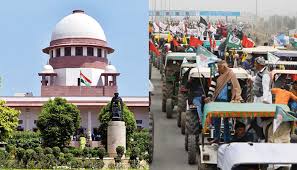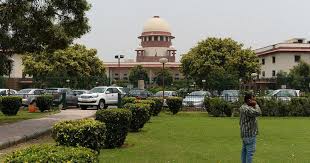Feature
SC seeks government response on sugarcane farmers plea

New Delhi: The Supreme Court on Friday sought the central government’s response on a plea by sugarcane farmers association seeking the implementation of the Commission for Agriculture Cost and Prices’ (CACP) report for 2015-16 and a price stabilisation fund.
A bench of Chief Justice H.L.Dattu, Justice S.A.Bobde and Justice Amitava Roy, while issuing notice, appreciated the serious issue being raised in a public interest suit and also referred to the newspaper reports on the spate of suicide by the sugarcane-growing farmers.
The CACP has recommended fixing sugar price on basis of fair and remunerative price to revenue sharing formula, whichever is higher, and the establishment of Sugar Stabilisation Fund so that farmers are paid their dues within reasonable time.
It also urged the government to take measure to cover the gap between cane price fixed by the government and the actual price which sugar mills are able to pay.
Senior counsel Rakesh Dwivedi appearing for the petitioner, the Consortium of Indian Farmers Associations (CIFA), drew the attention of the serious crisis that sugarcane farmers were passing through, resulting many of them in financial distress committing suicide.
The CIFA has also sought directions to the government to implement CACP recommendation to create a price stabilisation fund to meet the situations when sugar prices are in slide and sugar mill owners are unable to pay the farmers the price of their produce as it sought a lasting solution of the “chronic problem” that sugarcane farmers faced on year to year basis.
It contended that it was incumbent upon the government to ensure that sugarcane farmers get their full payments of FRP by “strictly enforcing the revenue sharing formula on the sugar mills and whenever same is below FRP, then meeting the shortfall out of the central fund as suggested by the CACP”.
The CACP has recommended for creating such a fund by levying a cess on sugar.
Saying the cess would help to bail out sugarcane farmers when in distress on account of price instability, the CIFA has said that levying a cess of Rs.4 to Rs.5 per kilogram would generate a fund of Rs.10,000 to Rs.12,500 crore that could be used in difficult situations.
Referring to the glut in the domestic and international market, it expressed apprehensions that this year the sugar mills may not even get last years “average ex-mill price” as the domestic sugar prices in the current financial year may not cross current rate of Rs.2,500 per quintal.
If that happens, then sugar mills would not be able to pay the basic remunerative cane price to the farmers, it warned, adding that this meant that not only the current arrears (Rs.15,000 crore) would not get fully cleared but it would be further compounded with fresh arrears for the current financial year.
Citing newspaper reports of farmers ending their lives because of unbearable financial burden, the CIFA in its petition has said that “a due to steep fall in sugar prices and accumulated stocks, the entire sugar sector is on the verge of collapse” and “due to financial crunch and losses incurred by the sugar factories during the last couple of years, over 30 percent of the factories are likely to stop crushing during 2015-16”..
Describing the current situation as “volcanic”, the CIFA has said that if government did not take corrective steps well in time it would leave the sugarcane farmers “high and dry, affecting their lives in carrying on their day to day activities” and will force them to embrace death out of depression and desperation.
Entertainment
Meghalaya Reserves Legalized Gambling and Sports Betting for Tourists

The State Scores Extra High on Gaming-Friendly Industry Index
Meghalaya scored 92.85 out of 100 possible points in a Gaming Industry Index and proved to be India’s most gaming-friendly state following its recent profound legislation changes over the field allowing land-based and online gaming, including games of chance, under a licensing regime.
The index by the UK India Business Council (UKIBC) uses a scale of 0 to 100 to measure the level of legalisation on gambling and betting achieved by a state based on the scores over a set of seven different games – lottery, horse racing, betting on sports, poker, rummy, casino and fantasy sports
Starting from February last year, Meghalaya became the third state in India’s northeast to legalise gambling and betting after Sikkim and Nagaland. After consultations with the UKIBC, the state proceeded with the adoption of the Meghalaya Regulation of Gaming Act, 2021 and the nullification of the Meghalaya Prevention of Gambling Act, 1970. Subsequently in December, the Meghalaya Regulation of Gaming Rules, 2021 were notified and came into force.
All for the Tourists
The move to legalise and license various forms of offline and online betting and gambling in Meghalaya is aimed at boosting tourism and creating jobs, and altogether raising taxation revenues for the northeastern state. At the same time, the opportunities to bet and gamble legally will be reserved only for tourists and visitors.
“We came out with a Gaming Act and subsequently framed the Regulation of Gaming Rules, 2021. The government will accordingly issue licenses to operate games of skill and chance, both online and offline,” said James P. K. Sangma, Meghalaya State Law and Taxation Minister speaking in the capital city of Shillong. “But the legalized gambling and gaming will only be for tourists and not residents of Meghalaya,” he continued.
To be allowed to play, tourists and people visiting the state for work or business purposes will have to prove their non-resident status by presenting appropriate documents, in a process similar to a bank KYC (Know Your Customer) procedure.
Meghalaya Reaches Out to a Vast Market
With 140 millions of people in India estimated to bet regularly on sports, and a total of 370 million desi bettors around prominent sporting events, as per data from one of the latest reports by Esse N Videri, Meghalaya is set to reach out and take a piece of a vast market.
Estimates on the financial value of India’s sports betting market, combined across all types of offline channels and online sports and cricket predictions and betting platforms, speak about amounts between $130 and $150 billion (roughly between ₹9.7 and ₹11.5 lakh crore).
Andhra Pradesh, Telangana and Delhi are shown to deliver the highest number of bettors and Meghalaya can count on substantial tourists flow from their betting circles. The sports betting communities of Karnataka, Maharashtra, Uttar Pradesh and Haryana are also not to be underestimated.
Among the sports, cricket is most popular, registering 68 percent of the total bet count analyzed by Esse N Videri. Football takes second position with 11 percent of the bets, followed by betting on FIFA at 7 percent and on eCricket at 5 percent. The last position in the Top 5 of popular sports for betting in India is taken by tennis with 3 percent of the bet count.
Local Citizens will Still have Their Teer Betting
Meghalaya residents will still be permitted to participate in teer betting over arrow-shooting results. Teer is a traditional method of gambling, somewhat similar to a lottery draw, and held under the rules of the Meghalaya Regulation of the Game of Arrow Shooting and the Sale of Teer Tickets Act, 2018.
Teer includes bettors wagering on the number of arrows that reach the target which is placed about 50 meters away from a team of 20 archers positioned in a semicircle.
The archers shoot volleys of arrows at the target for ten minutes, and players place their bets choosing a number between 0 and 99 trying to guess the last two digits of the number of arrows that successfully pierce the target.
If, for example, the number of hits is 256, anyone who has bet on 56 wins an amount eight times bigger than their wager.





















